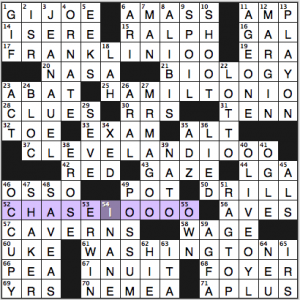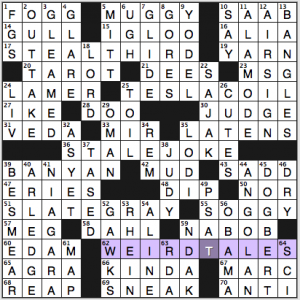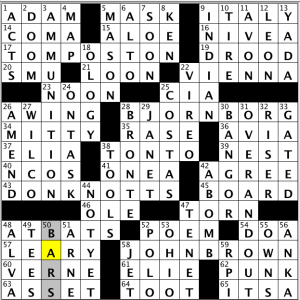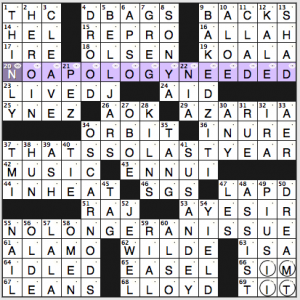NYT 3:13
LAT 3:02
Tausig untimed
CS 6:57 (Dave)
Richard F. Mausser’s New York Times crossword
It’s a cute theme, unless you’re one of those people who hates to see the letter I used as a numeral 1 and the letter O and numeral 0 similar interchangeable. The face and denomination of U.S. currency starting with $1 and escalating by powers of 10 are included:
- 17a. [Face value?], FRANKLIN IOO.
- 25a. [Face value?], HAMILTON IO.
- 37a. [Face value?], CLEVELAND IOOO. Not printed since 1934.
- 52a. [Face value?], CHASE IOOOO. Last issued in 1946.
- 52a. [Face value?], WASHINGTON I.
The Federal Reserve Banks used a $100,000 bill with Woodrow Wilson on the front in the mid-1930s.
German cross-referencing? Ach du Lieber! 35a. [Viejo : Sp. :: ___ : Ger.], ALT. That is super-tough if you don’t know your Spanish vocabulary, because there is not a damn thing in the clue that tells you the English meaning of the answer you need. And then 64d. [Opposite of 35-Across] is impossible if you haven’t figured out which German word is at 35a. ALT is old, NEU is new.
Nice to see toons MR MAGOO and OLIVE OYL ([Toon with size 14-AAAAAA shoes]) in the grid. Less nice to see ISERE, SEVE, EROSE, LAH, ARAL, HIE, and ADZ, which all feel a tad like crosswordese to me. Certainly none are words you are likely to hear in all your conversations tomorrow.
Three stars from me.
Gareth Bain’s Los Angeles Times crossword
This sort of partial-anagram theme can fall flat quite easily, but Gareth keeps it lively and juggles the fill well, and the overall effect is good.
- 62a. [Classic horror magazine, and a literal hint to the beginning of 17-, 25-, 36-, and 51-Across], WEIRD TALES. “Weird” might signal anagramming of the word that follows in a cryptic crossword.
- 17a. [Get closer to home?], STEAL THIRD. Wait, is this about cricket?
- 25a. [Electrical device named for its inventor], TESLA COIL. Who doesn’t love a Tesla coil? There’s a big one at the Museum of Science and Industry in Chicago.
- 36a. [Chestnut], STALE JOKE. Not quite “in the language,” but passable.
- 51a. [Dress pants shade], SLATE GRAY. Dress pants? All right, then.
I confess that I first assumed the theme would have to do with the letter G, since there are a bunch of G’s in the puzzle, particularly up top where I began solving. The record is 21 G’s in a daily LAT and this one only has 13, but it’s still a lot given that it’s not thematic. Clearly it’s Gareth’s overweening egotism that led him to lard the grid with his first initial.
Fave six:
- 42a. [Puddle gunk], MUD. What is it about the letter U that lends itself to these words? See also: muck, musty, fusty, dusty, ugly.
- 59a. [Big cheese]/60a. [Big cheese in Holland], NABOB and EDAM.
- 2d. [DVD extra], OUTTAKE. Who doesn’t love outtakes? Except when they’re nothing but the cast messing up their lines unexceptionally and laughing all out of proportion. I saw such dreadfulness on the Disney Channel once.
- 22d. [White co-worker], SAJAK. Vanna White. Not former Justice Byron White, not a Caucasian colleague. Although Pat Sajak is, in fact, white.
- 30a/38d. [With 38-Down, “People’s Court” rival], JUDGE JUDY.
- 5a. [Like weather that makes hair frizz], MUGGY. Although some of us have hair with zero innate frizzability. Humidity serves only to maintain the straightness of my hair.
Did not quite get 26d. [Affected preciousness, with “the”], CUTES. Do you use this or hear this?
Four stars from me. Enjoyed the MUGGY, SOGGY FOGG of G-fill.
Randall J. Hartman’s CrosSynergy/Washington Post crossword, “O Man” – Dave Sullivan’s review
Four men whose first and last names have no vowels other than the letter O:
- An entry that was fill in a recent CS puzzle (if memory serves), now makes it to the big time as a theme entry: [He played George Utley on “Newhart”] clues TOM POSTON.
- A [Tennis player who won five consecutive Wimbledon championships] is BJORN BORG – along with Chris Evert, Martina Navratilova, Jimmy Connors and badboy John McEnroe, he was the dominant tennis player as I was following the sport growing up.
- [He portrayed a deputy who was allowed to carry only one bullet] clues DON KNOTTS of Knott’s Berry Farm, of course.
- [Harpers Ferry raider] clues JOHN BROWN – the anti-slavery insurrectionist sometimes called “America’s first terrorist.” Do the ends justify the means?
Rather ho hum theme in my book; but having just four theme entries of 9 letters each did leave the constructor some leeway to add the even longer 10-lettter crossers AMMUNITION and OVER AND OUT. In general, I had a lot of false starts in this one and it took a bit longer than average as I struggled for traction in almost every quadrant. (Could be because I was solving this while watching The Voice finale last night–did you want Danielle Bradbery to win? I was definitely in the much more unique (and all kinds of awesome) Michelle Chamuel camp, not the least because she’s from my hometown area.) A clue like [Mardi Gras cover] had me thinking of floats not a MASK which covers the face, for instance.
My FAVE entry was BANGOR, a beautiful city in the “Pine Tree State” of Maine, which we see a lot less frequently than the neighboring (and less-populated) Orono, home to the University of Maine. Was a bit surprised to see what I know only as a suffix, -OLOGY clued simply as [Science]. My UNFAVE was seeing both director ELIA Kazan and statesman ELIE Wiesel in the same puzzle. One ELI? proper name per puzzle, please!
Ben Tausig’s Ink Well crossword, “Moving On”
I was flummoxed by the theme here when I test solved the puzzle a couple weeks ago, and had to ask Ben how this “I’M IT” pertained to the theme answers. D’oh! The word I’M is over the word IT, and “I’M over IT” is the key:
- 20a. [See the circled words], NO APOLOGY NEEDED.
- 37a. [See the circled words], THAT’S SO LAST YEAR.
- 55a. [See the circled words], NO LONGER AN ISSUE.
I’m glad I wasn’t the only one who was confused here. Not that it’s always desirable for a crossword to confuse people, but when the explanation comes, it’s a pleased “Oh!” rather than a disappointed “…Oh. That’s lame.”
Five more items:
- 9d. [Lasagna cousin], BAKED ZITI. Anyone remember that Byron Walden themeless from maybe 5-7 years ago in which BAked ZITi and BArry ZITo anchored the grid? I call it the BaZit puzzle.
- 10d. [Venerable topical treatment], ALOE. Fresh clue! And any remedy my grandma gave me certainly counts as venerable.
- 34d. [High-profile film nominations, as it were], OSCAR NODS. Nice fill.
- 45d. [Put a face to a name?], TAG. This is a Facebook reference, to tagging people in photos.
- 49d. [Pope who wrote obscene plays before becoming pope]. PIUS II. Cool papal trivia.
3.75 stars.




Hey Amy, or anyone else at Fiend, did you do and understand Tausig’s Moving On puzzle? See circled words? there were circled letters and I don’t get it.
It’s a rebus.
IM
IT
I’m over it.
Ahhhh … clever, this one. Enjoyed the “a ha” moment.
Since when did it become the goal of crosswords for every word to be familiar to a grade schooler? That’s not the intended audience of the Times puzzle.
–Will Shortz
Hmmm … Seems like as WS gets older and more ensconced in the job, he’s sounding a lot more like me. I like it.
Pretty sure ISERE and ADZ never came up in any of my college coursework. Is that graduate-level vocabulary?
And furthermore, there are plenty of smart solvers who complain routinely about the caliber of fill in the New York Times crossword. Often it could be made so much better with a few minutes of tweaking, but instead we are presented with some lackluster fill and told “This is the gold standard of crosswords.” Many disagree.
If I were the editor, the intended audience would be noncomplainers.
Hi Amy– Several thoughts in response to yours.
First, I do expect Times crossword solvers to be interested in words, even difficult ones. To me ADZ is an interesting, useful word, and one not even particularly common in crosswords. So I wouldn’t give it a negative mark at all.
Second, some of the answers listed in your blog as “obscure” or “things I know only from crosswords,” I think, Really? I know this from real life, from reading or life experience. I think everyone should show a little humility about gaps in their knowledge or vocabulary. The same advice applies to me. When I get a submission containing something I don’t know, I look it up to see if it’s something I think I should know. If I it is, and the puzzle is otherwise good, I’ll run it. Every time a solver doesn’t know something, it’s not necessarily a problem with the puzzle.
In judging the worth of a crossword, one has to look at it in its entirety. A puzzle with a high amount of theme material, like today’s, is naturally going to have more compromises than one with fewer theme entries. That’s just the nature of the beast. Altogether today’s puzzle doesn’t have much that’s bad.
One also has to balance the ISEREs and LAHs against the better fill, which today’s puzzle has a lot of — JEAN AUEL, MR MAGOO, SAVE AS, POSSUM, OLIVE OYL, RAGTOP, etc. I think the balance is pretty good.
Then as a practical matter, and speaking personally, consider that I have to edit a new puzzle every day, 365 days a year — fact-check, edit, typeset, email to four test-solvers, get their responses, revise the clues accordingly, etc. Also examine 75-100 submissions a week and respond to the contributors. And lots more. I have some help on all this, but it’s a big job. I work seven days a week. Practically speaking, I don’t think I can do much more.
You might be interested to know that today’s puzzle is actually a revision. Before I accepted it, I asked the constructor to remove LGE and ERISA, neither of which I cared to have in a crossword. But even if I agreed that EROSE, LAH, etc., should prevent this puzzle from appearing in print as is (which I don’t), consider that this is a first-time contributor. He may not be able to do any better. I don’t consider it my job to rework his entire construction.
Carry on.
–Will Shortz
I do think rookie constructors should be given more leeway by critics–and for a first time effort, this should be a good puzzle by anyone’s standards. I personally didn’t have a problem with the fill, and although I learned SEVE from crosswords and ADZ from playing Scrabble, I agree that they are interesting words, just to look at if nothing else. LAH is kind of weak as a partial, but the phrase in its entirety is definitely solid.
Also, very much agree that there are words and concepts worth learning about, and that they deserve a place in the crossword. And we all have different ideas about what’s worth learning about.
I, for instance, have no more interest in learning about Prince Valiant and his family tree.
I’ve always been puzzled that some words are considered a no-no in a grid, as opposed to others. If they’re considered legitimate enough for a dictionary or a Scrabble game, then why not here? And if the argument against them is “I don’t wanna learn anything I don’t already know,” then that sure sound like sheer laziness to me.
Of course, I’ll agree that too much of *anything* is bad, and while I have nothing against the occasional foreign word or roman numeral, I’ll be the first to complain if a grid is replete with them (http://www.fireballcrosswords.com/WorldsWorstCrossword.pdf, anyone?). What I mind more are stale clues that we’ve seen IOOO times, even when they are used for longer fill entries. On any given day, I’ll prefer an amusing definition of an ADZ to yet another pedestrian one for EASEL.
In point of fact, this is Richard Mausser’s fourth published puzzle. There is a whole world of crosswords outside of the New York Times.
Also, a constructor friend of mine came up with an ISERE-free replacement for that corner that retains JEANAUEL. RAJAS instead of GIJOE (not an improvement) atop ARENA, plus MEAL, TRUSS, and VIE in place of ABAT, CLUES, and TOE. Said it took him/her under a minute. So I’m not clear why it is considered so burdensome to tweak the fill and get more interesting, fun-to-clue words in there instead of things like ISERE. Given that you rework an average of half the clues as it is, Will, it doesn’t seem like changing a handful of entries and writing new clues would balloon the workload.
I am almost certain that solvers would not complain if they never saw fill like ISERE, ARN, and ERNE, etc., in another crossword. Their main value seems to be (a) making grids easier to fill and (b) giving long-time solvers another leg up on beginners who haven’t encountered the words before.
Also, given that about 80 puzzles a week need to be rejected, just based on the number of submissions, isn’t it incumbent on every published NYT puzzle to be an exemplar of what a crossword can and should be?
RAJAS is a much-less common variant of RAJAHS, so to me that is not a grid improvement, especially in place of the lively G I JOE.
I agree that newcomers should be held to the same standard as veterans.
Listing SAVEAS as “good fill” is something I personally wouldn’t do.
The clue is oh-so-dull and I put it on the level of Roman numerals myself (it’s a little contrived).
I have absolutely nothing against almost any individual piece of fill that’s appeared in the NYT/LAT/ND/CS, and others . My concern is simply that two things that aren’t well known should not be crossing each other. Cases in point:
ISERE/ISR/JEANAUEL
ARI/RALPH
NEMEA/ERWIN
EROSE/OSSO
I think it’s fine for the numerals 1 and 0 interchange with I and O, when they’re used consistently this way as part of a puzzle’s theme. The only reason this in an issue is because some puzzles in the past would occasionally use an entry like 100 (“Fever reading”) as a legitimate three-letter word for regular puzzle fill.
As for ADZ, if it wasn’t so late in the evening, I could
go down on of the larger hardware stores in town,
and snap a picture of a whole rack of
adzes. They’re not really that uncommon.
-MAS
Yes, ADZ(e)S aren’t that uncommon. But the problem is, is that if I asked someone what an ADZ was, they’d say it’s an AXE. The knowledge is limited to crossword solvers and some woodworkers/woodcutters.
Besides, ADZ is a great word for Scrabble or WWF.
However, Will’s aversion to ERISA is funny since he is a lawyer. Maybe that’s why he has an aversion? I like ERISA over EROSE, which I think gross.
I agree on ERISA, as someone who used to work in the 401k industry, ERISA was the federal rulebook for retirement plans.
I find it strange that the printing of 1000 dollar bills was ended before the printing of $10000 dollar bills. But to be reminded of Salmon P. Chase, a name that Magoo and Olive Oyl have nothing on in terms of cartoonishness, was fun.
You may well hear someone say “Lah di dah”, but I don’t think Seve Ballasteros is going to be on many people’s minds.
To be fair, there is a difference between the vocabulary that intelligent adults use and the words that every grade schooler is supposed to know. Will seemed a bit testy in his post today.
I find it much more reasonable to expect Americans to know basic Spanish than to know basic German.
According to Wikipedia, only 1.8 million people in the U.S speak German. For Spanish, it’s 37 million, a number that’s actually somewhat respectable.
A few years ago, a close friend of mine showed me a strong box he owned. Inside were four or five McKinleys and about the same number of Clevelands.
I had a question at the time as to whether there was a time-frame to turn these bills in before they expired. I am pretty sure that they are no longer legal tender, but I do not know whether they can still be turned into the government for payment.
Steve
Apparently, they can, but, like your chum, few in possession of them do so because they’re much more valuable to private collectors or museums than their face value….as it were.
Vide Large Denominations
Thanks, Dan. The site indicates that such bills are legal tender, but as you point out, who would use one to pay for anything?
On the other hand, another friend owned a convenient store in a low-income area of Buffalo and had a collection of hundreds of mercury dimes that customers had used to pay for items.
Stev
What foreign language you first learned, if born in the U.S. to English speakers, seems to me in large part to have been determined by your age group… I had Latin and French in high school, got into a top college and became interested in voice lessons which required some German and Italian as well… Then traveling to Russia and Greece, I found older parents of friends there had only German as a second language, those my age had French and then English, and their children had started with English. Now, my oldest grandson is fluent in Japanese and Korean, having taught English in the Far East for several years! So Spanish may look like an obvious choice for even younger Americans these days, but it probably depends on where you live and where you want to go… Note that we are all learning “hai” in crosswords!
Oh yes, I didn’t mean to imply that Spanish is the only language worth learning for young Americans. The more languages the better! But far more Americans speak Spanish as their first language than any other non-English language, so I think it’s reasonable to expect that even people who don’t make a point of studying it will pick up at least a few of the basics in their everyday lives. Of course, I live in Kissimmee, Florida, which has an overwhelmingly large Hispanic population, so it’s commonplace to me. Every day I hear people speaking Spanish in conversation at least a few times.
CS: TONTO is another theme answer.
Oh gawd, not again. I have to be more careful looking at that central entry, which is pretty humorous, since my recent NYT had a relatively hidden middle theme entry as well.
+1 for Jeffrey and RJH.
i can’t remember that i ever encountered the words isere or adz in college but i know them from crosswords.
Does anyone actually understand {It might be tossed out while picking up a blonde} for “Dart”. (recent BEQ puzzle.) Blonde in the politically incorrect sense of a human being, or a blond ale? As someone who has played darts in British pubs, you don’t toss them, you throw them. And you certainly don’t toss them “out.” Am I missing some subtlety?
As I understood it, a blond ale is being picked up, the dart is tossed, and you are right that the word “out” is probably adding one subtlety too many to the clue.
FWIW, I’d say picking up a blonde (person) and blonde (ale) are equally legitimate interpretations…
I too was stumped by the “I’m Over It” theme – reminded me of a riddle my dad told me once about an envelope that was addressed:
HILL
BOB
MASS
which was, of course, “Bob Underhill, Andover, Mass”. This was obviously before zip codes.
I have one nit (or question, anyway) about the Across Lite version of the NYT puzzle. I always thought that the adage “Across Rules” – so I was careful to put in the numbers for the theme answers and every one was wrong. I had to go back and fill in the letters for the down answers to get the correct solution. Am I, a novice, missing something here?
“Across Rules” is not a thing, so forget that!
It’s because the I’s and O’s represent the ones and zeroes, rather than the other way around. In older puzzles, I’s and O’s could stand in for numerals, so that IOOI would be an answer to “Number of Arabian nights” while crossing regular words. That convention has thankfully fallen by the wayside. (Except for a BEQ puzzle last month…)
I’d use it.
One of my pet peeves is that Will posts on Rex’s site and here and almost never on Wordplay. Maybe that’s because the comments on WP are usually favorable. Not sure why. In any event I find the discussion today interesting. I loved this puzzle, for its theme originality, its consistency and its relatively fresh fill. Like Amy, I paused at Alt but figured it out with the crosses. I figured out the theme early and went through it as fast as any Wednesday I recall without any help from Ms. Check. So I have no complaints. I must ask, however, if you are smarter than a 5th grader.
It’s possible that Amy paused at this bilingual, non-English crossing, but I took her comments to mean that the crossing would be tough for those who did not know VIEJO, and not necessarily that she had trouble with it. I didn’t know viejo really, but I thought of the French vieux. Alt might not present such a big problem even for those who don’t know much German, because the number of people who know that word is probably greater than the number who claim to speak German. It is related to the English “old” and “elderly,” and some form of the word is part of the name of lots of tourist spots.
This putative fifth grader prefers ERITU. Just sayin’
Hi, Amy, since it will be five weeks before I get to today’s NYT I have nothing to add to that discussion, but I did do Gareth’s LAT today and feel that although it is not very important in the great scheme of things, I might mention that Frank Sinatra had a song called “Come dance with me” that began “Hey there cutes, put on your dancing boots……..” I must say that otherwise I haven’t heard that word in general use.
Neat LAT Gareth!
As soon as I saw the clue for the revealer, I got excited. What horror magazine are we talking about? Tales from the Crypt? Vault of Horror? Ooh, Haunt of Fear? (My personal favourite, always loved those corpse-coming-back-from-the-grave-to-exact-horrific-revenge stories!) But no, those titles don’t lend themselves well to wordplay, do they?
I’ve never read Weird Tales, but i’m sure it was a hoot too.
Steve